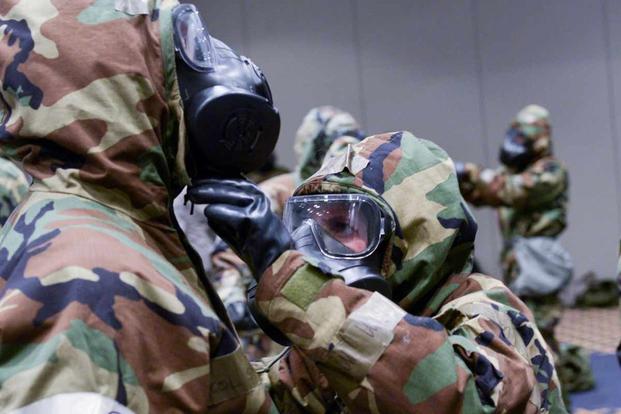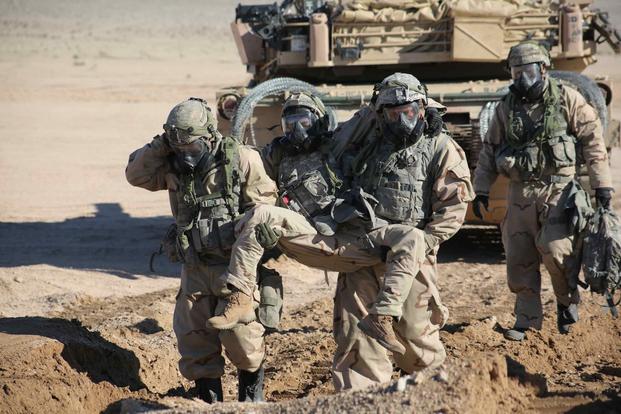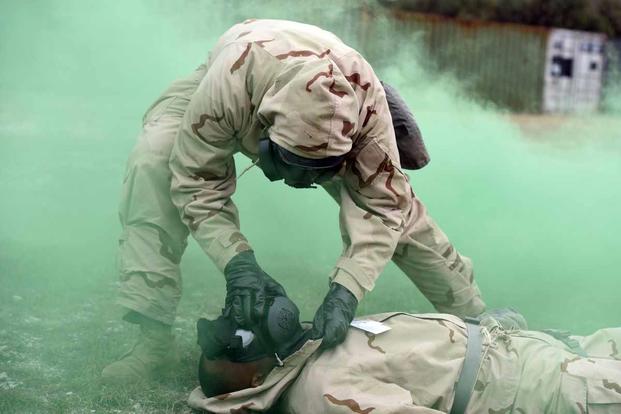As the world contends with the COVID-19 pandemic, civilian and U.S. military experts alike are voicing worries that combat units are ill-equipped to detect powerful new bioweapons that are likely to become a reality on the future battlefield.
Since the pandemic struck, the active-duty military has fared far better than the general population, thanks in significant part to its youthful population. While Defense Department-connected coronavirus cases have now surpassed 50,000, only six U.S. troops have died from the disease.
Nonetheless, COVID-19 has illustrated the ability of a biological threat to sideline military assets and cripple readiness. Early in the pandemic, the aircraft carrier Theodore Roosevelt had to pause deployed activities to contend with a massive outbreak that infected about 1,200 sailors; elsewhere, many combat training rotations were put on hold as units isolated for months to prevent spread of the disease.
The military has learned to adapt with new safety protocols, and operations are returning to a new normal. But experts say that COVID-19 was only a wakeup call: a harbinger for the next new threat that may not be a naturally occurring pandemic, but a sophisticated bioweapon that troops may not be able to detect or deter until it's too late.
Read next: 'Deadliest' Parris Island Marine Reveals the Secrets of His Record-Setting Shoot
Over the past decade, the joint force has focused its attention on the threat of cyberattacks from countries like Russia and China that can devastate communications, GPS and other battlefield tech. But the military's ability to operate on a chemical-biological battlefield is still calibrated for the last war, when the chemical weapons threat was the predominant focus.
"I am a lot more afraid of the biological threat than I am of the chemical threat," Dr. Peter Emanuel, senior research scientist for bioengineering at Army's Combat Capabilities Development Command's Chemical Biological Center, told Military.com. As the executive agent for the Defense Department, the Army is responsible for overseeing chemical and biological warfare defense programs for the services.

"My job is to make sure that the U.S. warfighter is safe on the battlefield that is contested. … When I am faced with a chemical threat, I have a lot of tools in my toolbox to give to the senior leaders," Emanuel said. "But when I am faced with a biological threat, I have very few."
A new age of biological weapons is now far more likely with recent advances in synthetic biology, a scientific revolution that could be a Pandora's Box that gives rise to deadly new strains of pathogens that are easily duplicated, scientists say.
The Pentagon is playing a significant role in Operation Warp Speed, a massive effort by government and private organizations that involves synthetic biology to develop and deliver 300 million doses of a COVID-19 vaccine by January 2021.
"That's how a vaccine is being made; we are using synthetic biology, purposely engineered biology to make the vaccine that is going to save the world," said Emanuel, the Army's lead for synthetic biology. But he worries that "super weapons" can emerge as easily as life-saving cures, he said.
"The same technology that is going to save you with a vaccine when Operation Warp Speed is complete," Emanuel said, "is the same technology that can create the next threat."
And there are very few short-term solutions to countering this new threat that can be accelerated with more money from Congress, experts maintain. Despite the warnings, there is little evidence that the Army has launched any initiatives to assess its readiness for the future bio threat.
Warnings Before COVID-19
The last time warnings emerged of U.S. adversaries possessing deadly biological and chemical weapons was in the lead-up to the 2003 invasion of Iraq, but fears that then-Iraqi leader Saddam Hussein would release weapons of mass destruction were based on faulty intelligence.
To prepare for such an attack, soldiers and Marines crossed into Iraq wearing chemical-biological protective suits known as Mission Oriented Protective Posture (MOPP) gear. U.S. combat units, believing the threat was real, inoculated troops against known pathogens such as smallpox and anthrax. Experts say that troops were likely more prepared then because they were dealing with known threats.
When COVID-19 hit nearly two decades later, it educated the world about how effective a global pandemic can be at creating an atmosphere of terror and helplessness while wreaking economic havoc.
The threat landscape is shifting as it becomes more likely that synthetic biology will allow scientists to alter pathogens such as anthrax, making them more resistant to traditional vaccinations and detection, experts say.
Scientists have been warning that natural pathogens distributed through trade and transportation are only a few of the perils that go along with this new biological revolution.
"Bioweapons have been with us a long time, but because of the revolution in biology that is going on, we have the capacity to make new, more powerful bioweapons that could evade all of our capacity to diagnose them and to treat them," Tara O'Toole, executive vice president of the not-for-profit scientific investment organization In-Q-Tel, testified at a November 2019 hearing before the Senate Armed Services Committee's subcommittee on emerging threats and capabilities.
"And it is very unlikely, given the difficulty of gathering intel on these programs, that we will have advance tactical knowledge of what weapon we might be facing or even where it might come from," she added.
O'Toole, the former undersecretary of Homeland Security for Science and Technology from 2009 to 2013, told lawmakers that the threat of new bioweapons and bioterror exists because of the advances that have been made in the life sciences in the past 40 years, which are now more accessible across the Internet.
"More and more people are going to have access to this technology as it becomes a foundational technology of the 21st century economy," according to the transcript of O'Toole's testimony.
Emanuel calls this the "democratization of science," meaning that the "first time you do something in science, it's very difficult, and then it becomes substantially easier as people have seen how you can do it."
In synthetic biology, scientists are applying the principles of engineering to biology to turn bacteria microbes into biomanufacturing, he said.
"As biotechnology becomes more mature and synthetic biology becomes the new thing, the democratization of biology now presents us with a conundrum -- Pandora's Box is open," Emanuel said. "I think that one of the concerns that has been bounced around ... is now that people have seen the power of biology to seize control of the global economy; does that make biology a more attractive weapon? Could the people that are intent on ill purpose suddenly rethink their ill-will to employ this technology? And that is a pretty scary thought."
From 2009 to 2019, the Government Accountability Office identified challenges in America's ability to detect and respond to biological events, highlighting vulnerabilities in biodetection technologies, biological laboratory safety and security, and emerging infectious disease surveillance, according to a June 2019 report.
In September 2018, the White House released the National Biodefense Strategy, which established a Biodefense Steering Committee including agencies such as the Defense Department, Department of Homeland Security, State Department and the Environmental Protection Agency.
But Dan Gerstein, a former Army officer and senior researcher at Rand Corp., says the U.S. is nowhere near ready to deal with future biological threats.
"I testified about a year and a half ago in front of the National Commission on Biodefense, and I followed a group of government guys. And the government guys were all happy to talk about how we coordinate and we share information and this and that," Gerstein, a former acting under secretary at DHS, told Military.com.
"I was the next one up, and I looked at the group and said, 'I hate to say this, but I'm like the turd in the punchbowl,' and I sort of laid into it. We are not ready. We don't have vaccines, we don't have protocols, we don't have [effective] biosurveillance."
Biodetection: the U.S. Military's Weak Link
Unlike a natural virus such as COVID-19, an effective biological weapon would cause exposed individuals to start showing signs of infection in hours, not weeks, said Gerstein, who holds a Ph.D in biodefense.
"If you had a properly prepared biological weapon -- think about a state-sponsored weapon -- it wouldn't act like a normal disease," he said. "You would have massive numbers of people who have received an overwhelming dose and ... you would actually see disease, in some cases, occur in hours."
When Gerstein was a signal brigade commander in the early 2000s, chemical-biological warfare training was always more focused on chemical weapons.

"The sensors are actually pretty good for chemical, and if you emplace them according to doctrine, you should get a warning," he said. "The problem with biological is, we are just not very good at detecting it, and so we have always worried."
One of the main bio-detection systems in the U.S. military's inventory is the Joint Biological Point Detection System, which is a box about the size of a dishwasher that fits inside combat vehicles like the Stryker Nuclear, Biological and Chemical Reconnaissance Vehicle.
It's designed to provide early warning and identification of aerosolized biological warfare agents. But the system is only somewhat effective against known agents, Thomas Spoehr, a retired Army lieutenant general and director of Heritage Foundation's Center for National Defense, told Military.com.
"They detect only a set number of biological agents; they detect anthrax, because that is a very powerful biological weapon, and they detect plague and some others," said Spoehr, who is a former commandant of the Army's Chemical, Biological, Radiological and Nuclear (CBRN) School at Fort Leonard Wood, Missouri.
"If somebody was to engineer something new that your [system] wasn't set up to detect, you wouldn't get a positive reading," he said.
So a new bioweapon could be created if an adversary, such as a state-sponsored terrorist group, had the scientific technical support to engineer a synthetic new strain of a deadly virus, Gerstein said.
"You have to be able to know what you are targeting and, with biology, you get strains that change … and that causes problems; it’s much more difficult than it is for, say, a chemical warfare agent," he said. "One strain of anthrax will be found by the detector; another strain may not.
"A guy in a cave is not going to be able to do this now," he added. "What about state-sponsored bio-terrorists -- probably very easy."
The main weakness of current biodetection technology is that it has very little standoff capability, Emanuel said.
"For chemical detection, I can actually detect chemicals with discrimination at distance," he said. "That means that I don't have to walk right up to a chemical and touch it in order to be like, 'That is going to kill me.'
Current biodetection is tied to wet chemistry, or analysis of substances in the liquid phase, Emanuel said.
"The difference between a bacteria that is just going to live in your mouth and going to be fine ... and anthrax or plague or a virus like AIDS or COVID-19, is really just a couple of clicks of a molecule, and so it's very difficult for me to differentiate or discriminate a good bio from a bad bio," he said. "The state of technology is, you are linked to wet chemistry. I have to go over and stick a swab down your throat and then put it in a little tube and then run a machine. The further away I get [from] touching a bacteria or a virus, the less fidelity I get. From across the room, forget it."
Congressional language in the House Appropriations Committee's fiscal 2021defense appropriations bill shows lawmakers expressing encouragement for the Defense Threat Reduction Agency's (DTRA) effort to develop a prototype sensor providing real-time detection of aerosolized biological threat agents.
In reality, DTRA's prototype is still in the very early stages of development, Emanuel said.
"If the detector proves effective, it will take many years before it is validated, produced and fielded to the U.S. military," he explained. "The reality is that we are limited in what current equipment is capable of performing."
Military.com asked the Army if the service is taking any steps to assess and possibly improve its biological agent detection capabilities based on threats emerging in the post-COVID-19 world, and was referred to the Defense Department.
Spoehr believes that the Pentagon has its hands full dealing with the massive response to the pandemic.
"I think in terms of the DoD’s response to this, they have adapted on the fly," Spoehr said. "In terms of long-term response, it’s too early. My guess is they are taking the posture of, 'Hey, let’s get through this and then we will do an after-action report and figure out whether we need to change anything.'
"Nothing long-term has changed yet; I suspect it’s going to change … but we may not see that for months."
Another concern among experts is what will happen once America moves beyond the hold of COVID-19.
Julie Gerberding, co-chair of the Commission on Strengthening America's Health Security at the Center for Strategic and International Studies, touched on the problem when she testified, along with O'Toole, at the November 2019 Senate Armed Services hearing.
"When biothreats are recognized, policymakers do allocate emergency resources, but ... once the crisis fades and public attention subsides, urgency morphs into complacency, investments dry up, attentions shift and a false sense of security takes hold," she said in the transcript of the hearing.
It's not just about money, Emanuel said.
"You can't just throw money at this particular problem; it's a combination of three things," he said. "It's a combination of guided intent, money ... and science making some specific advances on fundamental problems."
-- Matthew Cox can be reached at matthew.cox@military.com.
Related: As Military and VA Coronavirus Cases Surpass 50,000, Recovery Indicators Appear













